The Sapphire R9 280X Toxic Review
by Ryan Smith on October 10, 2013 8:00 AM EST- Posted in
- GPUs
- Radeon
- Sapphire
- Tahiti
- Radeon 200
Overclocking
Our final evaluation criteria is overclocking. And this will be short and sweet, as the 280X Toxic isn’t really designed for end user overclocking in the first place. Without voltage adjustment and already shipping at clockspeeds towards the tail end of the curve for the Tahiti GPU, there was absolutely no GPU overclocking headroom for our sample. It was rock solid at stock, but even 10MHz more would eventually result in artifacts when validating the overclock.
Every card will be different of course, and we certainly expect some 280X Toxic cards to have some unexploited headroom, but in the case of our card there was none to be found. Sapphire has fully exploited the available headroom of the GPU in their factory overclock.
| Radeon R9 280X Overclocking | |||||
| Sapphire Radeon R9 280X Toxic | XFX Radeon R9 280X DD | Asus Radeon R9 280X DCU II TOP | |||
| Shipping Core Clock | 1100MHz | 850MHz | 970MHz | ||
| Shipping Boost Clock | 1150MHz | 1000MHz | 1070Mhz | ||
| Shipping Memory Clock | 6.4GHz | 6GHz | 6.4GHz | ||
| Shipping Boost Voltage | 1.256v | 1.2v | 1.2v | ||
| Overclock Core Clock | 1100MHz | 880MHz | 1010MHz | ||
| Overclock Boost Clock | 1150MHz | 1030MHz | 1110MHz | ||
| Overclock Memory Clock | 7GHz | 6.6GHz | 6.8GHz | ||
| Overclock Max Boost Voltage | 1.256v | 1.2v | 1.263v | ||
Now the memory overclock on the other hand was more promising. We were able to get our card up to 7GHz, 600MHz (9%) over the shipping memory frequency and a full 1GHz over what the Hynix modules on the card are technically rated for. Of course the 280X already has so much memory bandwidth that the payoff from additional memory bandwidth isn’t quite as great as say a GTX 770, so coupled with the lack of a core overclock the performance gains are miniscule.
While we’re on the subject, it’s worth pointing out that the 280X Toxic has the highest PowerTune limit of any Tahiti card we’ve tested thus far. Unlike every other card, which tops out at +20% (for 300W or so), the Toxic can go to a full +50%, or somewhere north of 375W. For our testing purposes we stuck with 20% for consistency – the additional headroom wouldn’t be of any value in our games as far as we can tell, as opposed to letting FurMark go nuts – but if it were possible to do voltage adjustments on this card, hardcore overclockers would certainly have a lot of headroom for their water/exotic cooled setups.
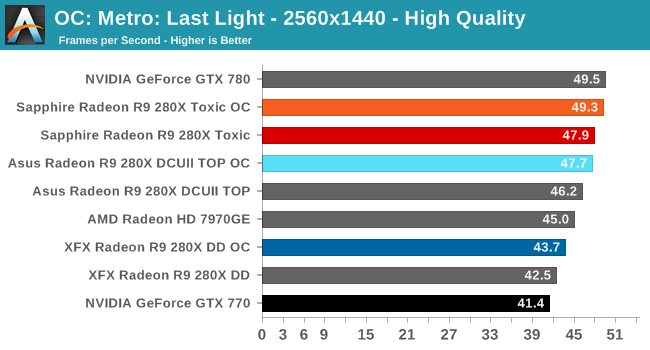
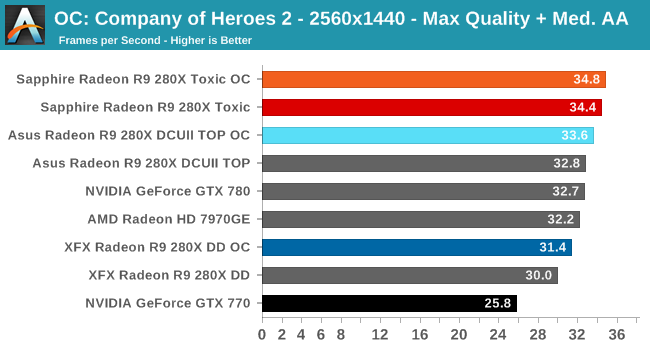
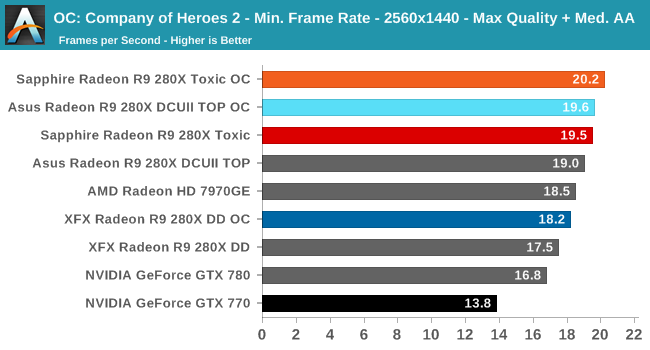
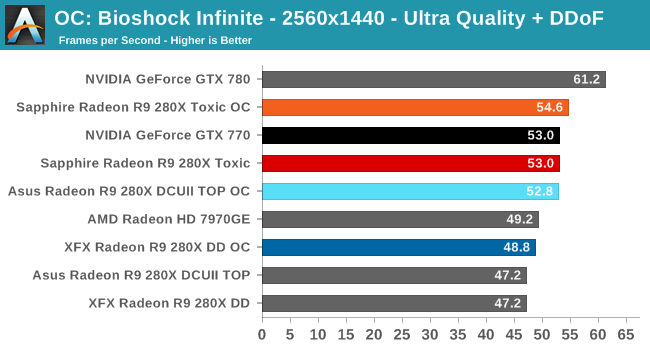
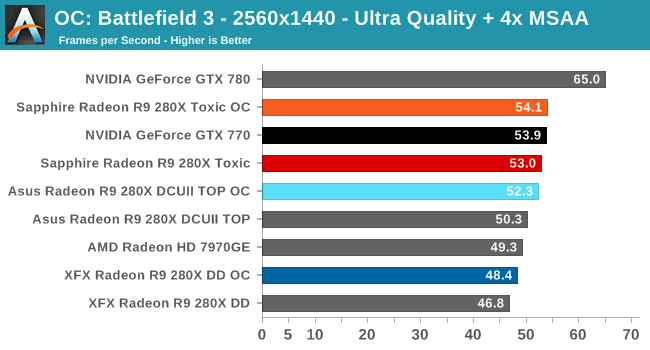

Despite the lack of gains from overclocking, the 280X Toxic is still the fastest 280X card even at stock. Our second best overclocking 280X is the Asus card, which topping out at a boost clock of 1110MHz still falls short of what the Toxic can achieve, and that was after supplying the Asus card with additional voltage. Undoubtedly some 280X cards with voltage adjustment will do better, but our results do paint a very convincing picture for just running the 280X Toxic at stock and ignoring all other cards, with or without overclocking.
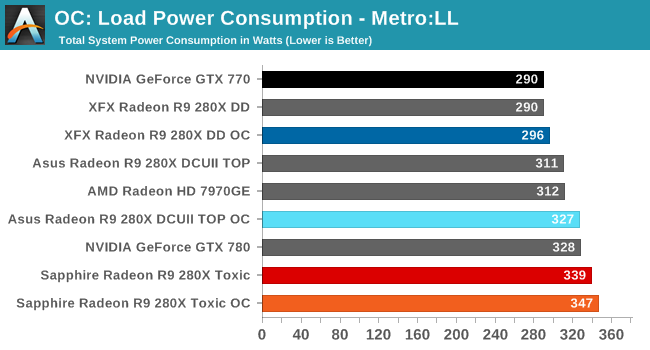
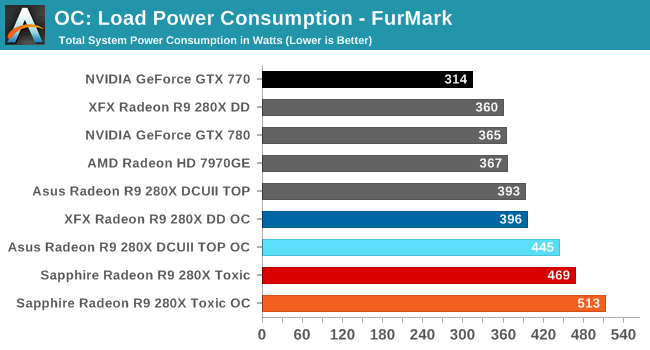
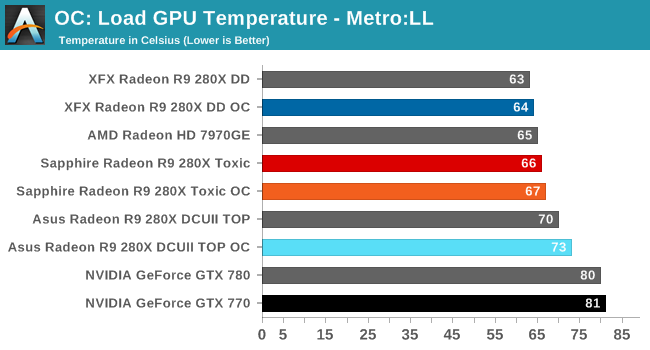

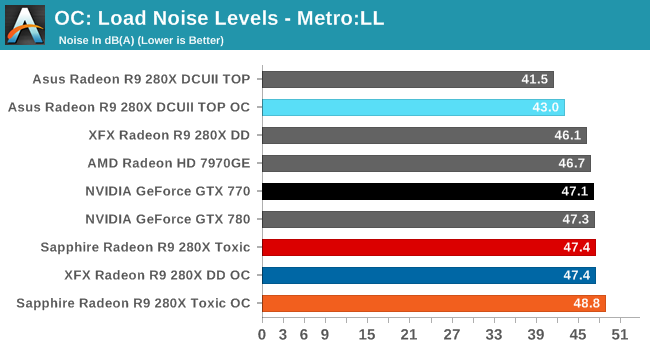
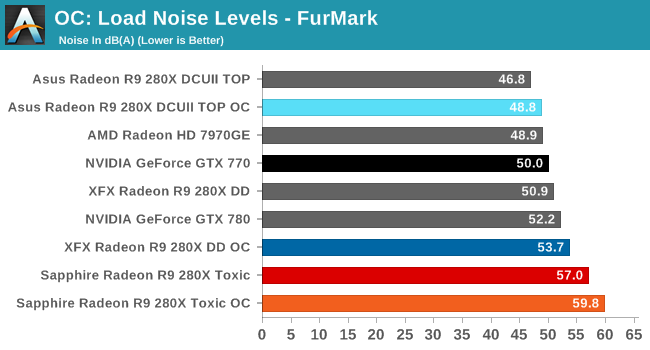
Since we can’t increase the GPU clock or the voltage of the 280X Toxic, the power/temp/noise hit is immaterial under Metro and other gaming workloads. You get almost nothing extra in performance for almost nothing extra in power/temp/noise. With our overclocked results thrown into the mix we can also see that while the stock 280X Toxic outperforms even our overclocked Asus 280X in gaming performance, it also does so while drawing more power than said overclocked Asus card. Clearly nothing is free here; more performance will cause a notable increase in power consumption.
Moving on to FurMark, with that 20% PowerTune increase FurMark absolutely goes nuts. 519W at the wall off of a single card is well out there, and the cooling performance also reflects this. This is all the more reason to leave the 280X Toxic at stock.










84 Comments
View All Comments
marc1000 - Thursday, October 10, 2013 - link
wow, really nice factory OC there, I liked the cooler performance! still waiting fot 290/290x to show up... I bet we will have "non-X" versions of the smaller cards too, but launched a few months from now.anyway, this is mostly just curiosity. I just purchased one GTX660 (non-TI) as it is the fastest card with just 1 PCIe power connector, and I believe this keeps noise and heat manageable with smaller cases for casual gaming.
ShieTar - Thursday, October 10, 2013 - link
Technically, the 660Ti has a TDP and should also run perfectly well with a single connector. I think it only comes with 2 connectors to provide a bit of security versus bad PSUs, or in order to give you a little head room for overclocking. But yeah, for casual gaming the 660 gives the best price-performance ratio for anybody who needs more than iGPU performance.Of course the fastest card within a 150TDP would be an underclocked and/or undervolted Titan.
marc1000 - Thursday, October 10, 2013 - link
yeah, the hd7870 also seems to eat the same amount of power than gtx660, but also has 2 connectors for "safety". too bad nothing changed in 150wTDP world with this new re-spin of products - we will have to wait for 20 or 14nm for that. not a problem for me :)The Von Matrices - Thursday, October 10, 2013 - link
Since when is having an 80mm fan surrounded by two 90mm fans "asymmetric." That's the very definition of symmetry. Asymmetry would be if the 80mm fan was on one side of the card and the 90mm fans were in the other two places.piroroadkill - Thursday, October 10, 2013 - link
Fact.treeroy - Thursday, October 10, 2013 - link
The Asus is more expensive and is notably slower, and I don't have to worry about overclocking with the Sapphire.I wonder which one I'll buy.
Nice review by the way - glad to see a review of this card at last, this one hasn't got a lot of coverage but it's the one I've been eyeing.
Skiddywinks - Thursday, October 10, 2013 - link
What? The Asus is $40 cheaper.treeroy - Thursday, October 10, 2013 - link
Here in the UK, the Sapphire card is $430 and the Asus one is $440 [USD]Skiddywinks - Thursday, October 10, 2013 - link
I'm actually in the UK myself and assumed you were a Yank. My bad. Where are those prices btw, cause I am looking to upgrade my GPU and these 280X are tempting as sin itself.treeroy - Thursday, October 10, 2013 - link
Those are on Overclockers UK - http://www.overclockers.co.uk/search_results.php?k...I can't find many places selling the cards, but OCUK was the cheapest of what I saw.